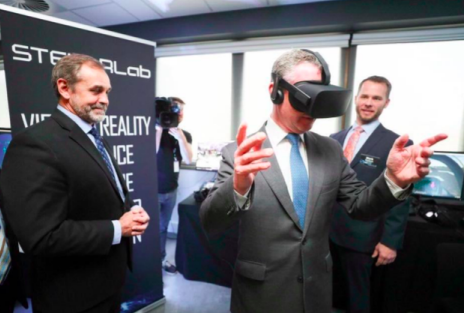|
Vol 12, Issue 12 LUKE THOMAS Melbourne’s Militarised Research The man shooting the finger guns while wearing a VR headset, above, is Christopher ‘The Fixer’ Pyne. This photo was posted on his Facebook page in August after he visited University of Melbourne’s STELaRLab, the first Lockheed Martin-funded research facility outside the US. Pyne’s visit to STELaRLAB was a showcase for the first bit of tech to come out of this partnership, the unveiling of autonomous unmanned aerial vehicles (drones) that are able to efficiently and cheaply survey power lines while recharging their batteries through an induction loop, allowing them to survey autonomously for days. Powerline surveying formerly cost the government $1 billion a year to complete by helicopter, so even The Fixer was impressed by how well they fixed the energy industry.
STELaRLab fits nicely with the University’s ‘Growing Esteem’ 2015-2020 strategic plan, which explicitly contemplates public-private partnerships and industry connections as a way to ‘establish a small number of precincts as the locus platform for research commercialisation and impact creation.’ On the one hand, this is an understandable (and lucrative) partnership for the University. Lockheed Martin is an aerospace company as well as a weapons manufacturer, and not all of their products and services lead to civilian casualties. Their recent contracts include securing a bid to build communication satellites for the US government and to develop energy security infrastructure for US army bases in Texas. However, what most of the Australian government and University conversation around jobs, growth, and ‘impact creation’ omits is that, at its simplest, Lockheed Martin is the leading manufacturer of weapons for the US military industrial complex. And it has fought hard to retain its market share, no matter the implications for human rights or global stability. They currently operate a multimillion-dollar PAC with targeted donations for US House Armed Services Committee members—and hold one of the largest defence industry lobbying budgets in the US. A former Lockheed president even admitted to extensive bribery and political manipulation to secure contracts over their decades-long involvement with post-WWII US military expansion. Their products are ubiquitous in global warfare. Their Hellfire missiles are dropped over Afghanistan. Their F-35A’s will patrol Korean skies. They maintain business ties with Saudi Arabia, despite brutal bombings in Yemen. And if the sale weren’t blocked by the Obama administration in 2015, the military forces suppressing human rights protesters in Bahrain would have been using Lockheed Martin aircraft. While STELaRLAB improvements in UAV technology have wider, non-military application for infrastructure projects and energy security, it’s worth considering what impact their research will have on Lockheed’s arms manufacturing--and where they intend on using these innovations next. Australia has had an increasing role in US warfare, and the recent Pine Gap revelations show just how connected the two countries are on intelligence and warfare. And while I’m not suggesting the recent advancements in UAV technology created by the brilliant engineers at STELaRLAB will be used for deadlier purposes, it’s clear from public statements that the STELaRLAB is being built to achieve Lockheed’s research goals. Aviation Australia quoted Pyne at the recent event as saying the partnership “will make Australia a better ally to the US…more able to defend our nation and its people, more capable of projecting our power in the region and being a regional power that is standing up for the values that our countries . . . believe in.” The Lockheed Martin—University of Melbourne relationship is both pragmatic and myopic. The reality of the competitive innovation and research industry is that the University is making a financially sound decision in seeking funding and facilities from a US weapons manufacturers. That’s the reality. The dream would be for the University to instead provide greater investment in researching how to reduce the use of these weapons to make a more peaceful world. P.S. For a more thoroughly researched analysis of the growing militarisation of university research, check out Alex Edney-Browne’s excellent article: https://medium.com/@alexedneybrowne/australian-universities-becoming-militarised-9b65f7c64076 Luke Thomas is a third-year JD student The rest of this issue (:O)
22/2/2018 01:11:20 am
I’m always about progress, especially if we are talking about technologies that can make our life better. It’s great that this kind of researches have financial support. On other hand, I agree with that video that was posted in the end of 2017. That video was about how easily drones can turn to be a weapon, in the military hands. If I remember it right, it was advertisement about obligatoriness of law that must regulate all this drone issue. I think that government must have better care of regulating progress in some ways. Comments are closed.
|
Archives
October 2022
|



